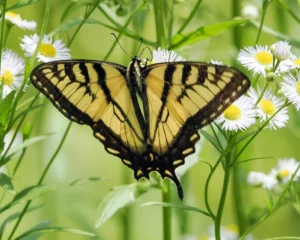
July 25, 2011
Remembering Sylvia Harris

Butterfly in meadow, Seal Cove, Maine, 2011
In the spring after my mother died, I was in the garden with our daughter, Fiona, then just four years old, when we noticed a large, orange butterfly. Wherever we went, went the butterfly — through the garden, past the stone walls, up and down the hill — hovering near us for close to an hour.
“Buddhists believe that after a person dies, their soul remains present for awhile,” I told Fiona. “So maybe that butterfly is really Nini,” I added, referring to the name our children used for their grandmother. “It’s kind of nice to think of Nini here with us in the garden, isn’t it?”
Fiona poked at the earth with her plastic shovel, pretending to plant something, and said nothing. And I thought no more about this until about 6 months later, when my husband’s mother was visiting for the Christmas holidays. Fiona was playing one evening in her bath, when she suddenly became very pensive.
“Daddy’s mother is downstairs,” she announced, a propos of nothing. “You used to have a mother, but now your mother is a butterfly.”
—–
I first met Sylvia in 1979, when I was still a teenager and she was a graduate student in graphic design at Yale. Even then, she was a force: smart, poised, clear-headed and without a pretension in the world. Upon graduating, she partnered with two classmates to form 212 Associates — a witty nod to 212 York Street, the address where Yale then housed its graduate students in graphic design — and thus began a career that would oblige the rest of us to reconsider what design was, what designers did and how they did it. In a profession perhaps best characterized by its wish to bring clarity to a chaotic world, Sylvia Harris was a champion.
But my experience of Sylvia was a personal one — tethered to professional practice in a way, but enriched and ennobled by who she was, not what she did. And because I was there in those first critical hours after she fell, I want to share a more personal side of my friend Sylvia.
So, here goes.
Sylvia had skin the color of a perfect capuccino. She had enviable, long legs, and beautiful hands, and a big, hearty laugh that filled the room. She celebrated Easter and Passover with equal zeal, loved India and Italy with equal intensity, and was as mindful about her daughter’s need for a new pair of mittens as she was the future of the American philatelic program. (I should know: we discussd both, at the same time, last winter.) Her advocacy for democracy came from a profound desire to help people and to listen to them: she routinely shared epiphanies with me, following a trip or a conversation in what others might see as the most mundane of circumstances. She loved to talk to real people, to understand what they wanted and needed, to understand how their perceptions impacted or framed something — wayfinding in a hospital lobby, for example, or census forms or postage stamps. That kind of field research was essential to what she did, and she took it seriously.
But not too seriously.
Recently, we stood side by side at the Cooper-Hewitt National Design Museum, as we’d both been asked to participate in the First Day Issue ceremony for the Pioneers of Industrial Design stamps. As ever, Sylvia looked beautiful, elegantly dressed in a crisp white shirt and narrow black skirt, yet it was she who complimented me on my dress, which I confessed to having bought second-hand. She whooped with laughter (such a Sylvia thing to do!) and pointed to her blouse. “Armani sample sale,” she whispered, “and the skirt comes from a consignment shop. Now you know my secret.”
Another bond, and a silly one: but it points out something that deserves to be said, which is the degree to which really good people are more than a sum of their really great parts. I have always valued my women friends for precisely this: their ability to spin on a dime, waxing poetic about a book, strategic about a client, or nostalgic about a family recipe for lemon cake all in the same breath. Because life is made of all of these things, and the boundaries that separate them — even for those among us with the clarity of vision and self-discipline and razor sharp intellect, like Sylvia — are porous and kinetic, always on the move.
Not unlike that butterfly, actually.
A week ago today, I spent those first 10 hours with Sylvia in the hospital, where I tried, in my own bumbling way, to be her advocate: from the ER to the ICU and many places in between, I sweet-talked triage nurses and badgered security guards, wielding my visitor’s pass like a would-be magic wand. No, I was not family: yes, I was her family’s man-on-the-ground until they could get there. I phoned and texted up-to-the-minute news briefs as I had them, but these were few and far between, and the hours drifted by. The doctors and nurses at George Washington University Hospital were extraordinary. The emotional support from members of the Citizen’s Stamp Advisory Committee — where Sylvia was when she was taken ill — was unyielding. Yet I still felt helpless. And was. And am, in the wake of this tragedy.
I feel like there was life until last Thursday morning, and life from this point forward.
The day after Sylvia died I drove to Maine with my family, where I am now as I write this, still trying to make sense of the events of the past week. Occasionally I am, as so many of us are, overcome with grief: Sylvia and I shared so much, and the chapters in our lives — both professional and personal — intertwined on so many levels. I know I am only one of so many who were touched by her wisdom and humor and grace. I have no words of comfort for myself or for any of us, no explanation, no understanding of how to proceed, although I do think if Sylvia were here she would tell me to snap out of it and get back to work.
A very wise friend of mine reminded me recently that there is no light without shadow, a concept that bears acute significance as I sit in my painting studio here, grieving, healing, struggling to come to terms with the thinnest of lines that separate life and loss. It is not much of a consolation, but it does remind me that the Buddhists have it right: it’s all a cycle, isn’t it? Sylvia, of all people, understood that. She understood what people needed — high and low, Armani and consignment, darkness as well as light — and she’d understand us needing to mourn her now.
And then she’d tell us to snap out of it.
______________________________________________________
This announcement was originally posted on July 25, 2011.

It is with the deepest sadness that I write this post to tell you that Sylvia Harris, dear friend and esteemed member of the design community, passed away peacefully on Sunday, July 24th, 2011. She was surrounded by more than 20 family and friends who flew in from all over the country to be at her side, and is survived by her sister, Juliette Harris, her husband Gary Singer, and their beautiful daughter, Thai.
Sylvia collapsed on Thursday morning during a meeting in Washington, and was immediately rushed to George Washington University Hospital, where she later died. The cause was complications due to heart failure. She was 57.
I was with Sylvia when she fell, and stayed with her for the first few hours, until her family could be at her side. This is an unspeakable loss to our community, to those of us who knew and loved her, to a world that benefitted in countless ways from her intelligence and humor and insight and so much more. We will post a longer tribute to Sylvia later this week, and until then, welcome your thoughts, your memories, and of course, your prayers for her family.
Observed
View all
Observed
By Jessica Helfand
Related Posts

Design Impact
Seher Anand|Essays
Food branding without borders: chai, culture, and the politics of packaging

Graphic Design
Sarah Gephart|Essays
A new alphabet for a shared lived experience

Arts + Culture
Nila Rezaei|Essays
“Dear mother, I made us a seat”: a Mother’s Day tribute to the women of Iran

The Observatory
Ellen McGirt|Books
Parable of the Redesigner
Recent Posts
Food branding without borders: chai, culture, and the politics of packaging Why scaling back on equity is more than risky — it’s economically irresponsible Beauty queenpin: ‘Deli Boys’ makeup head Nesrin Ismail on cosmetics as masks and mirrors Compassionate Design, Career Advice and Leaving 18F with Designer Ethan MarcotteRelated Posts

Design Impact
Seher Anand|Essays
Food branding without borders: chai, culture, and the politics of packaging

Graphic Design
Sarah Gephart|Essays
A new alphabet for a shared lived experience

Arts + Culture
Nila Rezaei|Essays
“Dear mother, I made us a seat”: a Mother’s Day tribute to the women of Iran

The Observatory
Ellen McGirt|Books

 Jessica Helfand, a founding editor of Design Observer, is an award-winning graphic designer and writer and a former contributing editor and columnist for Print, Communications Arts and Eye magazines. A member of the Alliance Graphique Internationale and a recent laureate of the Art Director’s Hall of Fame, Helfand received her B.A. and her M.F.A. from Yale University where she has taught since 1994.
Jessica Helfand, a founding editor of Design Observer, is an award-winning graphic designer and writer and a former contributing editor and columnist for Print, Communications Arts and Eye magazines. A member of the Alliance Graphique Internationale and a recent laureate of the Art Director’s Hall of Fame, Helfand received her B.A. and her M.F.A. from Yale University where she has taught since 1994.